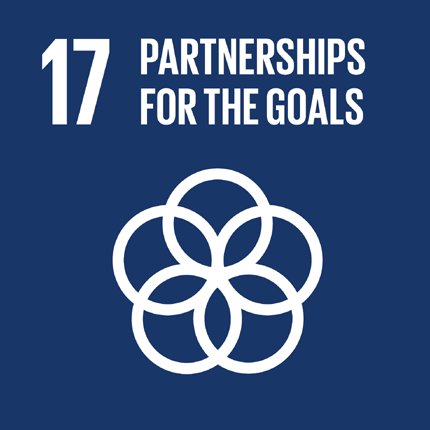sdg17
SUSTAINABLE DEVELOPMENT GOAL 17
Strengthen the means of implementation and revitalize the global partnership for sustainable development
Progress of goal 17
- Achieving the ambitious targets of the 2030 Agenda requires a revitalized and enhanced global partnership that brings together Governments, civil society, the private sector, the United Nations system and other actors and mobilizes all available resources. Enhancing support to developing countries, in particular the least developed countries and the small island developing States, is fundamental to equitable progress for all.
Finance
- In 2015, net ODA from member countries of the Development Assistance Committee of OECD totalled $131.6 billion. Taking account of inflation and the rise in the value of the dollar in 2015, this was 6.9 per cent higher in real terms than in 2014, and represented the highest level ever reached. Total ODA from those countries as a share of their gross national income was 0.30 per cent, on par with 2014. Most of the increase was owing to higher expenditures for costs associated with refugees. However, even if those costs are excluded, ODA still rose by 1.7 per cent. Seven countries met the United Nations target for ODA of 0.7 per cent of gross national income in 2015: Denmark, Luxembourg, the Netherlands, Norway, Sweden, the United Arab Emirates and the United Kingdom.
Information and communications technology
- Fixed-broadband services remain largely unaffordable and unavailable across much of the population in developing regions, highlighting digital divides in access to high-speed, high-capacity Internet services. By 2015, fixed-broadband penetration had reached 29 per cent in developed regions, but only 7.1 per cent and 0.5 per cent, respectively, in developing regions and the least developed countries. Major disparities are also found in Internet use. In developing regions, one third of the population is online versus 1 in 10 people in the least developed countries. Data also reveal that more men than women are online. In 2015, globally, the Internet user penetration rate was about 11 per cent lower for women than for men. The gender gap is even higher in developing regions (15 per cent) and highest in the least developed countries (29 per cent).
Capacity-building
- Net ODA for capacity-building and national planning amounted to $23 billion in 2014; of that total, sub-Saharan Africa received $6 billion and Southern and Central Asia received $4.6 billion. The main sectors receiving assistance were public administration, environment and energy, which together were allocated a total of $9.3 billion.
Trade
- The weighted average of applied tariffs has been decreasing over time, but still varies widely across regions and country groups on main product sectors. Average agricultural tariffs on imports coming into Asia, for instance, are the highest in the world, at around 27 per cent for Southern Asia and 20 per cent for Eastern Asia in 2015, under most-favoured nation status.
- In 14 years, the least developed countries’ share in world merchandise exports nearly doubled, from 0.6 per cent in 2000 to 1.1 per cent in 2014. The key driver of export growth during that period was a massive rise in the price of fuel, ores and metals, reflecting a high demand in developing countries, notably China. In services, the least developed countries increased their share of world exports to 0.8 per cent in 2014 ($40 billion), up from 0.5 per cent in 2005.
Data, monitoring and accountability
- The requirements of the indicators developed in the context of the Millennium Development Goals have fostered stronger national statistical plans and systems. The number of countries with a national statistical plan increased in some regions between 2010 and 2015, including in sub-Saharan Africa and the least developed countries. However, the overall number of plans declined from 56 to 54 among the countries being observed, since the time period of some existing plans expired.
- Financial support for statistical capacity amounted to $325 million in 2013, compared with $379 million in 2010. However, assistance to the least developed countries, in this regard, tripled during the period and reached $265 million. Despite an increasing awareness of the importance of statistics for evidence-based policymaking and development, the share of ODA dedicated to statistics hovered at around 0.3 per cent between 2010 and 2013.
- Population and housing censuses are a primary source of the disaggregated data needed for formulating, implementing and monitoring development policies and programmes. During the 10-year period spanning from 2006 to 2015, 90 per cent of countries or areas around the world conducted at least one population and housing census.
- Over the period 2005-2014, birth registration data were available for 183 out of 230 countries or areas, whereas death registration data were available for 157. Only 58 per cent of developing countries with available data have birth registration coverage of 90 per cent or more; 71 per cent of developing countries with available data have death registration coverage of 75 per cent or more. Sub-Saharan Africa has the lowest levels of complete birth and death registration.
Source: United Nations, Department of Economic and Social Affairs, SUSTAINABLE DEVELOPMENT KNOWLEDGE PLATFORM
The National Indicators for Sustainable Development Goal 17 are:
- Total government revenue as a proportion of GDP, by source
- Proportion of individuals using the Internet
- Number of countries that have national statistical legislation that complies with the Fundamental Principles of Official Statistics
- Number of countries with a national statistical plan that is fully funded and under implementation, by source of funding
- General government gross debt
- Shares of environmental and labour taxes in total tax revenues - % of total taxes
All available data in .xls file:
- Partnership for the goals
Last Updated: 29/4/2025
EU SDG indicator set
To measure SDG achievement in an EU context, an EU SDG indicator set was developed under the leadership of Eurostat. The purpose of this set, which is structured along the 17 global Sustainable Development Goals, is to monitor progress towards the SDGs at the European level.
- For the complete set of indicators available in the Eurostat database, click here.
- To compare Greece’s progress on specific indicators for each Sustainable Development Goal, click here [data visualisation].

